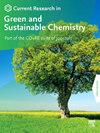增强丝绸纺织品的可持续性:柚木叶提取物染色和抗菌效果的优化
Q2 Materials Science
Current Research in Green and Sustainable Chemistry
Pub Date : 2025-01-01
DOI:10.1016/j.crgsc.2025.100457
引用次数: 0
摘要
本研究介绍了一种从柚木幼叶(Tectona grandis L.)中提取的色素染色丝绸的环保方法,提供了一种可持续的解决方案,以减少合成染料的污染,同时重新利用农业废弃物。乙醇(95%)提取的柚木叶中含有丰富的多酚类和类醌类化合物,可制得适合染色的红褐色色素。优化了染色温度(30-100℃)、持续时间(10-60 min)和pH(3-11)等关键染色条件,以最大限度地提高颜色吸收和均匀性。通过分光光度法(L∗,a∗,b∗值)和K/S测量评估显色性能。三种媒染剂,包括明矾(硫酸铝钾),硫酸亚铁和氯化亚锡进行了测试,使用前,中,后媒染剂技术。用硫酸亚铁预涂布可获得最深的色调和最高的色强,以及出色的耐洗和耐光性(灰色等级≥4)。红外光谱显示通过分子配位形成稳定的染料媒染剂配合物。在琼脂孔扩散试验中,染色蚕丝对金黄色葡萄球菌和大肠杆菌表现出温和的抗菌性能,尽管抑制范围不大(0.20 cm),可能是由于残留的生物活性化合物。这些结果将柚木叶提取物定位为一种集美观、生态和卫生优点于一体的多功能天然染料。通过与循环经济原则相一致,这种方法为可持续纺织品生产提供了一条可行的途径。尽管如此,未来的研究应侧重于优化提取方法,提高抗菌功效,并扩大工业应用的过程。本文章由计算机程序翻译,如有差异,请以英文原文为准。

Enhancing sustainable silk Textiles: Optimization of teak leaf extract dyeing and antibacterial efficacy
This study introduces an environmentally friendly method for dyeing silk using pigments extracted from young teak leaves (Tectona grandis L.), offering a sustainable solution to reduce pollution from synthetic dyes while repurposing agricultural waste. Ethanol (95 %) extraction of teak leaves showed a rich in polyphenols and quinonoid compounds, which yielded a reddish-brown pigment suitable for dyeing. Key dyeing conditions, including temperature (30–100 °C), duration (10–60 min), and pH (3–11), were optimized to maximize color absorption and uniformity. Color performance was evaluated through spectrophotometry (L∗, a∗, b∗ values) and K/S measurements. Three mordants including alum (aluminum potassium sulfate), ferrous sulfate, and stannous chloride were tested using pre-, meta-, and post-mordanting techniques. Pre-mordanting with ferrous sulfate delivered the darkest shades and highest color intensity, along with excellent wash and light fastness (rated ≥4 on the Grey scale). FTIR spectroscopy revealed stable dye-mordant complexes formed through molecular coordination. The dyed silk exhibited mild antibacterial properties against Staphylococcus aureus and Escherichia coli in agar well diffusion tests, though inhibition zones were modest (<0.20 cm), likely due to residual bioactive compounds. These results position teak leaf extract as a multifunctional natural dye, combining aesthetic, ecological, and hygienic advantages. By aligning with circular economy principles, this approach presents a viable pathway for sustainable textile production. Nonetheless, future research should focus on optimizing extraction methods, boosting antimicrobial efficacy, and scaling the process for industrial applications.
求助全文
通过发布文献求助,成功后即可免费获取论文全文。
去求助
来源期刊

Current Research in Green and Sustainable Chemistry
Materials Science-Materials Chemistry
CiteScore
11.20
自引率
0.00%
发文量
116
审稿时长
78 days
 求助内容:
求助内容: 应助结果提醒方式:
应助结果提醒方式:


